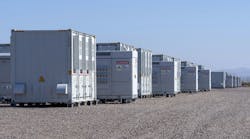Sun-soaked states like Arizona, California and Hawaii have been clamoring for energy storage and new ways to release energy generated during the day in the evening. Arizona, for example, plans to add 3,000 MW of storage capacity by 2030. Last fall, California passed a law designed to speed up storage projects. It will help the state reach its goal of sourcing 50 percent of its electricity from renewables by 2030.
“The peak for solar power generation is at noon,” says Eric Gebhardt, vice president of strategic technology for GE Power. “What if you could store this energy and release it six hours later when the sun goes down and people come home, start cooking dinner and watch TV?” Gebhardt asks.
Gebhardt is more than ready to meet this challenge. Having started at GE 27 years ago, he’s had a front-row seat to the energy industry’s transformation, including the rise of natural gas and combined-cycle power plants, and GE’s push into wind energy and the smart grid. “It’s been a journey, but the common thread is the energy ecosystem,” he says. “The grid is an ecosystem that needs many different pieces. Storage is a piece that’s been missing for a while.”
That’s precisely the point of GE’s Reservoir, a new grid-scale energy storage system the company recently unveiled. The Reservoir will allow producers to “decouple when energy is produced and when it is consumed,” Gebhardt says. “Without it, if you have too much solar during the day, the only option you have is to curtail production.”
There are other benefits. Last year, GE demonstrated the system’s black start capabilities last year, when it used a similar system to restart a gas-fired power station in California’s Imperial Valley. It can also help operators stabilize the grid. “We want to reduce carbon, reduce costs and increase the reliability of the whole grid system,” Gebhardt says. “It’s a big step forward.”
Another milestone last year was Southern California Edison’s launch of the world’s first hybrid power plant. The design, which has won six industry awards, includes a gas turbine with a GE battery system that kicks in when the wind stops blowing or the sun isn’t shining and allows the turbine to step in and ramp up to full power.
In the past, power supply was pretty predictable, generated by steady sources like thermal and nuclear power plants. What fluctuated was customers’ need for power, or load, as the industry calls it. But with the advent of wind and solar power, which depend on inherently fickle weather — the wind doesn’t always blow and sun doesn’t always shine — “the ecosystem became much more complex,” Gebhardt says. “With storage, we can start absorbing some of that intermittency” and smooth out the fluctuations on the generation side.
Engineers have been looking for effective ways to store large amounts of energy ever since the dawn of electricity more than a century ago. They came up with successful designs like pumped storage, which stores and releases energy by moving water between two lakes built at different levels. But affordable grid-scale batteries have remained out of reach until recently.
GE’s Reservoir solution will have a 15 percent longer life and 5 percent higher efficiency than comparable technology. By assembling and testing the units in a factory, GE will also shave off installation time by as much as 70 percent from what’s usual.
The rise of the electric car unleashed innovation in the battery space, and the spread of solar power has brought costs down 50 percent over the last four years, says Keith Longtin, product breakout leader at GE Global Research in Niskayuna, New York. “You are now getting to a point where energy storage starts to make sense,” he says.
“You’ve got storage, you’ve got solar and you’ve got policy all changing very quickly and coming together,” he says. “If we have solar at less than $1 a watt, and if I have energy storage at $250 a kilowatt-hour, I can start to make a system that stores energy during the afternoon and uses it in the evening. This is very disruptive.”
The GE Reservoir consists of modular, grid-scale batteries that can stack together like Lego blocks. Each of these 1.25-megawatt systems holds 16,000 lithium-ion battery cells that can release 4 megawatt-hours of energy, enough to supply customers for four hours.
While GE Power buys the battery cells for the system from producers like Samsung, LG and others, Longtin’s team at GE Global Research and other GE units supplied many of the goodies inside.
For example, Reservoir is equipped with sensors that gather information about the state of charge, temperature, voltage, current and other factors. The data can be analyzed on site in real time using a technique called edge computing, or it can travel to the cloud for a deeper dive.
In addition, Longtin’s engineers have developed apps that leverage Predix, GE’s app development platform for the industrial internet, and allow operators to monitor each battery’s health, control its operations, even maximize revenues by optimizing battery life against profits. “We want to see as far down into the system as possible,” Gebhardt says. “We want to understand what’s changing in the charge-discharge cycle and spot degradation when it starts happening. The way we designed the systems gives us more knobs to turn than the competition.”
The battery management system will also include power electronics made from silicon carbide. This wonder material, which combines features from diamond, one of the toughest materials in the world, with silicon, the workhorse of the semiconductor industry, is notoriously difficult to work with. The silicon carbide chips inside the storage system to protect and manage individual battery blades and extend their life by as much as 15 percent. “This represents a tremendous amount of value,” Longtin says.
The engineers also found a way to feed direct current from solar panels directly into the batteries, rather than converting it into alternating current and back, which generates losses. “It basically got a DC plug on one side, and, depending on where you want to use it, a DC or AC outlet on the other side,” Longtin says. “This feature adds another 5 percent in efficiency over the way the industry does it today.”
Finally, by assembling and testing the units in a factory, GE will also shave off installation time by as much as 70 percent from what’s usual. “It shows up as one 20-foot container, you drop it on the foundation, you hook it up and move on the next one,” Gebhardt says.
The team is looking for ways to bring data from all the batteries to a single digital monitoring center, digital monitoring center, similar to what Gebhardt’s business is already doing with power plants at its headquarters in Atlanta, and use it to optimize entire fleets of the storage systems. “The reality is that storage is on an exponential growth,” Longtin says. “It will give power producers and grid operators a degree of freedom they never had before. One of the engineers on my team jokes that storage is like bacon. It makes everything better.”
The full GE Report is available at this link, along with a related video.
-Tomas Kellner, Editor in Chief, General Electric


